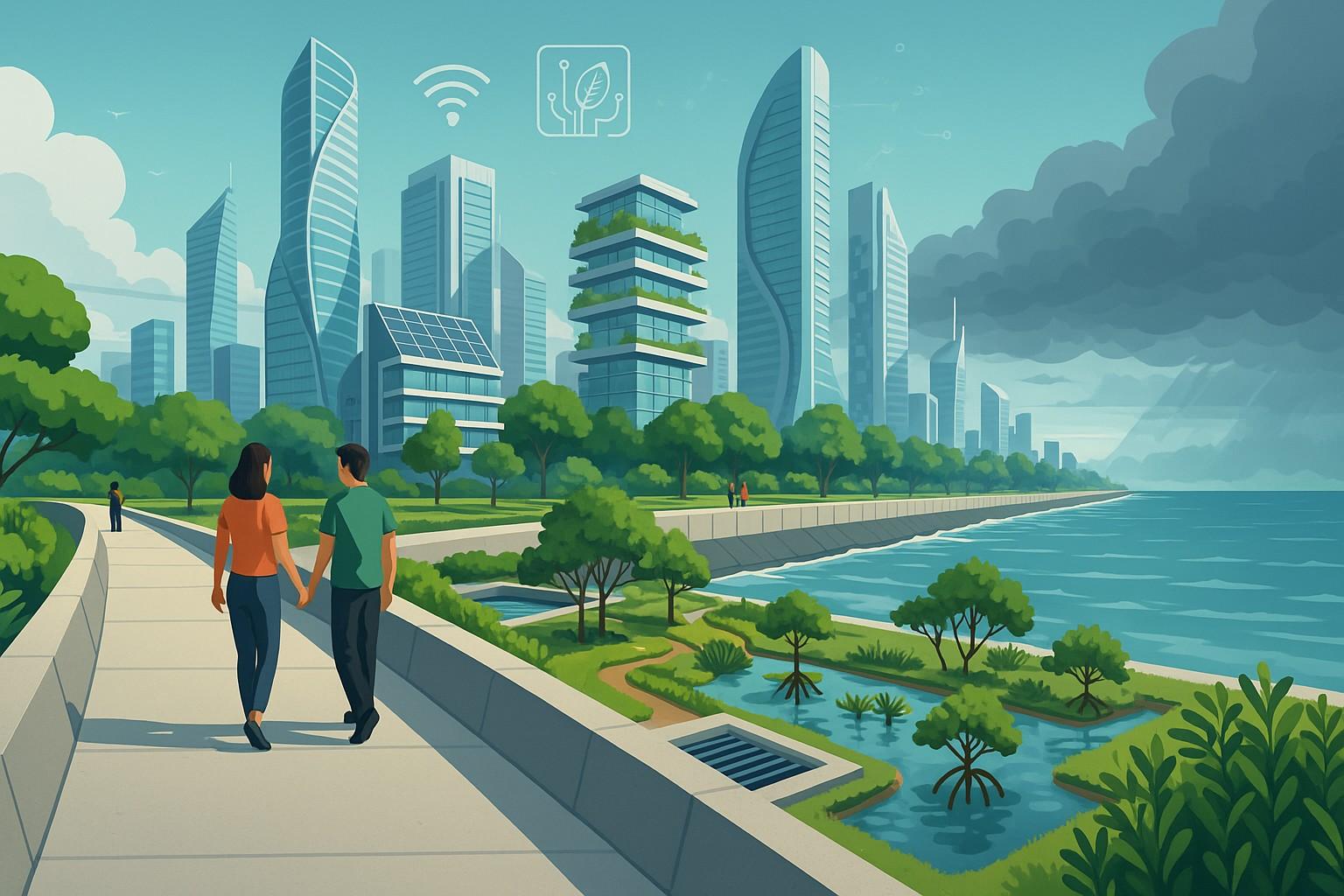Climate change poses a significant and growing threat to coastal cities worldwide. Rising sea levels, increased frequency of extreme weather events, saltwater intrusion, and coastal erosion are endangering ecosystems, infrastructure, human health, and economic stability. As urban populations continue to grow, especially in low-lying coastal areas, the urgency of implementing effective climate adaptation strategies becomes more pronounced. This abstract explores the multifaceted approaches adopted by coastal cities around the globe to mitigate risks and enhance resilience in the face of climate change.
Coastal cities are uniquely vulnerable due to their geographical positioning and often dense populations. Global warming, driven by increased greenhouse gas emissions, has accelerated polar ice melt and thermal expansion of oceans, contributing to a steady rise in sea levels. This exacerbates the risk of storm surges and tidal flooding. Moreover, higher temperatures can intensify cyclones and hurricanes, leading to catastrophic consequences for unprepared urban centers. In response, adaptation strategies must be both proactive and integrative, encompassing environmental, infrastructural, social, and policy dimensions.
One key strategy is the development of resilient infrastructure, including sea walls, storm surge barriers, elevated buildings, and improved drainage systems. Cities like Rotterdam and New York have pioneered engineering innovations that integrate climate resilience into urban design. Additionally, green infrastructure, such as wetlands restoration, mangrove plantations, and urban green spaces, provides a nature-based buffer against climate impacts while enhancing biodiversity and air quality.
Another crucial element is urban planning and zoning. By regulating land use in flood-prone areas and promoting climate-resilient architecture, cities can reduce vulnerability and promote safer development. Managed retreat—relocating populations and assets from high-risk zones—is a controversial but increasingly considered option, particularly where physical defenses are unfeasible or too costly.
Community engagement and capacity building play vital roles in successful adaptation. Educating the public about risks and involving local communities in planning processes ensures that strategies are culturally appropriate, equitable, and widely supported. In cities like Jakarta and Dhaka, community-based adaptation initiatives have proven effective in increasing awareness and preparedness. Policy frameworks and governance mechanisms also underpin adaptation efforts. Effective governance requires coordination across local, national, and international levels. Policies must incentivize sustainable practices, enforce environmental regulations, and facilitate access to climate finance. Global cooperation is essential, as climate impacts transcend national borders. Organizations like the United Nations Framework Convention on Climate Change (UNFCCC) have emphasized the importance of adaptation in global climate agendas.
Moreover, data-driven decision-making supported by climate modeling, geographic information systems (GIS), and early warning systems enhances preparedness and allows for dynamic, evidence-based planning. Investments in research and technology further aid in understanding localized climate risks and developing innovative responses. In conclusion, adapting to climate change in coastal cities is not only a technical challenge but also a socio-political and economic one. It requires a holistic and interdisciplinary approach, leveraging both technological advancements and community resilience. As climate risks escalate, the ability of coastal cities to adapt effectively will be crucial in securing sustainable urban futures across the globe.
1. Hard Infrastructure Solutions
Traditional engineering approaches, such as seawalls and levees, have been employed to protect coastal cities from flooding and erosion. For instance, the city of Pacifica in California has been granted a 20-year permit to expand seawalls and rock revetments along its shoreline to mitigate storm impacts and rising sea levels. This decision, however, has sparked debates regarding the environmental consequences of shoreline armoring and its long-term efficacy.
Similarly, Singapore has invested significantly in coastal protection measures, including the construction of the Marina Barrage and the proposed ‘Long Island’ project, aimed at safeguarding low-lying areas against sea-level rise. The country has also launched a S$125 million Coastal Protection and Flood Management Research Programme to enhance its capabilities in this domain.
2. Ecosystem-Based Adaptation (EBA)
Ecosystem-based adaptation involves the sustainable management and restoration of ecosystems to reduce the vulnerability of human communities to climate change impacts. In Indonesian coastal regions, efforts have been made to restore and conserve natural habitats such as mangroves, coral reefs, and sea grass beds. These ecosystems act as natural buffers, mitigating the effects of storm surges and coastal erosion while supporting biodiversity and local livelihoods.
The Netherlands has also implemented ‘soft’ protection approaches, such as the construction of artificial dunes in the Spanjaards Duin project, which leverages natural processes to enhance coastal resilience.
3. Managed Retreat and Strategic Relocation
Managed retreat involves the deliberate relocation of infrastructure and communities away from high-risk coastal areas. While controversial, this strategy is gaining attention as a long-term solution to sea-level rise and increased storm risk. In the United States, several communities have undertaken buyout programs to relocate residents from vulnerable zones.
The Tuvalu Coastal Adaptation Project (TCAP) exemplifies proactive measures in this regard. Launched in 2017, TCAP aims to build the capacity of the national government and local communities to adapt to climate change through infrastructure projects and land reclamation efforts. Notably, the project includes the construction of berm top barriers and the development of a platform above storm surge levels to protect against coastal erosion and flooding.
4. Technological Innovations and AI Integration
Advancements in technology, particularly artificial intelligence (AI), offer new avenues for climate adaptation in coastal cities. AI can enhance predictive modeling, allowing for more accurate forecasts of sea-level rise and storm impacts. For example, AI-driven systems are being utilized to optimize water management in Rotterdam, monitor coastal ecosystems in Singapore, and improve flood forecasting in Miami.
Furthermore, the integration of urban digital twins with cloud-based geospatial dashboards enables visualization of vulnerabilities within critical infrastructure, facilitating informed decision-making in adaptation planning.
5. Community-Based Adaptation and Policy Frameworks
Engaging local communities in adaptation planning is crucial for the success of climate resilience strategies. In Indonesia, community-based adaptation initiatives empower residents to develop and implement strategies that address their unique vulnerabilities, integrating traditional knowledge and cultural practices.
Policy frameworks also play a vital role. Mumbai’s Climate Action Plan, launched in 2022, outlines a roadmap for the city to achieve net-zero greenhouse gas emissions by 2050. The plan encompasses six key action areas, including sustainable waste management, urban greening, and flood management, aiming to enhance the city’s resilience to climate change.
6. Addressing Land Subsidence and Urban Planning
Land subsidence, often exacerbated by groundwater extraction and urban development, poses additional challenges to coastal cities. A recent study revealed that 25 of the 28 largest U.S. cities are experiencing subsidence, increasing their vulnerability to flooding. Cities like Seattle have incorporated subsidence data into zoning laws and infrastructure improvement strategies to mitigate these risks.
Conclusion
Climate change continues to pose an existential threat to coastal cities across the globe. Rising sea levels, increased frequency and intensity of storms, saline intrusion, and land subsidence are already affecting millions living in vulnerable coastal zones. This research paper has examined various adaptation strategies being implemented globally—with a strong emphasis on recent developments in Asia—to address these multifaceted challenges. A synthesis of these approaches reveals the importance of a comprehensive, multi-sectoral, and forward-looking adaptation framework for safeguarding urban coastal environments and the communities that inhabit them.
One of the foremost strategies is the development of hard infrastructure, such as seawalls, levees, and storm surge barriers. While these provide immediate protection, they often come with long-term ecological trade-offs and high maintenance costs. The example of Pacifica in California and the massive seawall construction in Jakarta, Indonesia, illustrates both the necessity and controversy surrounding engineered defenses. Nevertheless, in high-risk urban environments, these structures remain critical components of adaptive planning.
Equally important is the growing emphasis on ecosystem-based adaptation (EBA) solutions. The restoration and conservation of mangroves, coral reefs, dunes, and wetlands serve not only as natural buffers against climate-related hazards but also as essential ecological assets. Countries such as Indonesia, Bangladesh, and Sri Lanka have made considerable progress in deploying EBA methods. For instance, Indonesia’s coastal regions benefit from mangrove rehabilitation projects that strengthen shorelines while supporting biodiversity and local economies.
Another increasingly adopted strategy is managed retreat or strategic relocation. This approach, though politically and socially challenging, is gaining traction as a viable long-term adaptation tool. The Tuvalu Coastal Adaptation Project (TCAP) exemplifies proactive retreat measures, including land reclamation and elevation to counteract sea-level rise. Similarly, policy frameworks in U.S. cities have incorporated buyout programs to move residents from high-risk zones, reflecting a broader shift towards retreat where other options may be unsustainable.
Innovation plays a crucial role in enhancing climate resilience. The use of artificial intelligence (AI), digital twin technologies, and real-time geospatial monitoring tools is revolutionizing climate adaptation. In Singapore and cities in Florida, these technologies are being leveraged to create data-driven, responsive urban planning systems that anticipate and respond to climatic threats with precision.
Community-based adaptation is another essential pillar. In Asia, particularly in regions like Palawan in the Philippines and coastal areas of Bangladesh and India, local communities are being empowered to co-develop adaptation strategies. These grassroots initiatives harness traditional knowledge and local leadership to enhance ownership and effectiveness.
Furthermore, the integration of climate adaptation into urban governance and policy is vital. From Mumbai’s Climate Action Plan to China’s Sponge City initiative, large cities are mainstreaming adaptation into their urban development frameworks. These strategies emphasize flood management, green infrastructure, and emission reduction, demonstrating the interconnection between mitigation and adaptation.
In conclusion, adapting to climate change in coastal cities requires a holistic and multi-layered approach. Structural solutions, ecological restoration, technological advancement, community participation, and policy integration must converge to build resilient, inclusive, and sustainable urban futures. The diverse strategies employed by coastal cities across Asia and the world highlight the need for localized responses informed by global knowledge. As climate risks escalate, the urgency for comprehensive, equitable, and scalable adaptation measures has never been greater.
References:
1. “California Coastal Commission balks at seawalls. It made an exception for crumbling Bay Area city”
2. “Climate change in Singapore”
3. “Climate Change Adaptation Strategies in Indonesian Coastal Regions – Suara Dari Laut”
4. “Coastal Adaptation to Climate Change and Sea-Level Rise”
5. “Managed retreat”
6. “Tuvalu Coastal Adaptation Project”
7. “AI-Driven Climate Adaptation in Coastal Cities → Scenario”
8. “Integrating urban digital twins with cloud-based geospatial dashboards for coastal resilience planning: A case study in Florida”
9. “Mumbai Climate Action Plan”
10. “Why are the world’s cities sinking?”
11. “Seattle is sinking citywide, new study shows”
– Dr. Dushyant Kumar, Associate Professor
Faculty of Law, Madhav University

